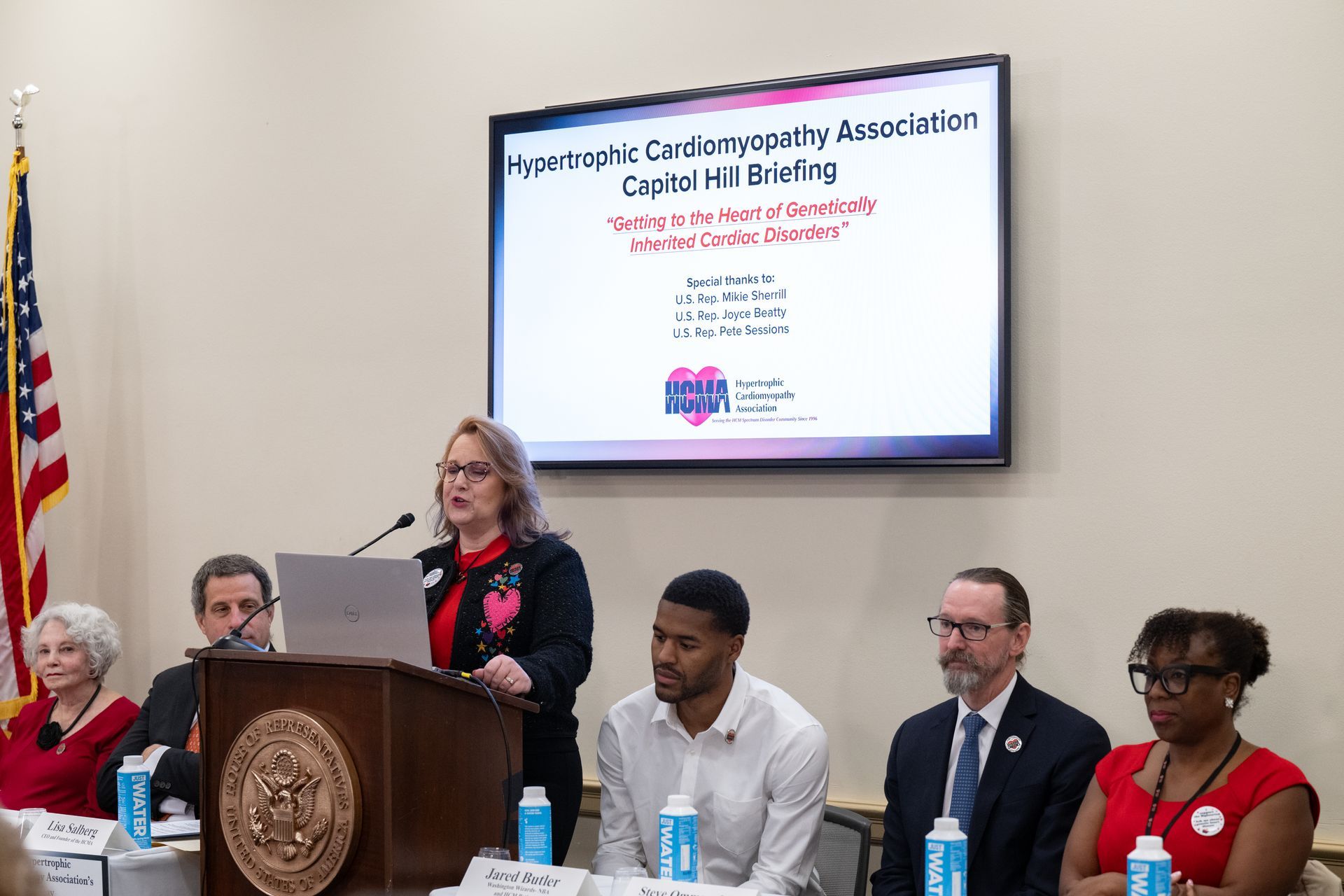When symptoms of obstruction (such as shortness of breath, exercise intolerance, light-headedness, and fainting) persist despite using medications, or if obstruction severely restricts blood flow from the heart to the body, it’s time to consider septal reduction. What kind of septal reduction therapy is suitable for any patient depends on many factors you can discuss with your HCM team. If you need help understanding these options or would like guidance on how to speak with your doctor, please contact the HCMA.
Camzyos is the first FDA-approved medication for the treatment of symptoms of obstruction in HCM. It’s worth a try for some people before they move on to invasive procedures. For others, it may be a long-term solution that allows them to avoid invasive procedures but because it is so new we don’t know. Other medicines for this purpose are currently in clinical trials.
A septal myectomy is open-heart surgery used to treat the obstruction to blood flow caused by thickening of the heart muscle or an interplay between valves, papillary muscles, or chordae (parts of the internal functioning of the left ventricle and mitral valve). Myectomy removes tissue from the septum that separates the left and right ventricles below the aortic valve. A myectomy eliminates or significantly reduces the obstruction. After this procedure, patients often report feeling rapid relief of their symptoms.
Sometimes obstruction is partly caused by structural issues of the mitral valve, and these can be repaired or the valve replaced during the myectomy surgery. In addition, if atrial fibrillation (afib) is present, a MAZE may be performed during the myectomy surgery.
Because open heart surgery allows all of these procedures to be performed at one time, and because of the relief of symptoms, the myectomy is called “the gold standard” of septal reduction. The safest place to have a myectomy is a high-volume Center of Excellence for HCM.
For those with the proper anatomy, an alternative, less invasive procedure is available for septal reduction called alcohol septal ablation (ASA). In an ASA, a thin, flexible catheter with a balloon tip is threaded through a blood vessel in your groin to the artery that carries blood to your septum. Alcohol is inserted through the catheter. This will kill some heart muscle cells, causing the tissue to shrink over time. The balloon is then deflated and removed from your body.
While ASA seems appealing because it is less invasive, myectomy has a stronger record of both safety and success. Myectomy is not recommended for patients who are poor risks for surgery. Generally, this means people who are frail because of age or other medical conditions. An ASA may reduce obstruction in those people and relieve many symptoms. Because ASA requires very particular heart anatomy, it cannot be done in every patient. If you also need mitral valve repair, coronary artery bypass, or repositioning of the papillary muscles, they cannot be done during an ASA. Finally, ASA often causes a Right Bundle Branch Block, which disturbs the heart’s electrical conduction (although you aren’t likely to have any symptoms or problems from it alone). Septal myectomy often causes a Left Bundle Branch Block. If you have an ASA and your obstruction isn’t relieved, and a myectomy is needed later, this may lead to a complete heart block, and you could become pacemaker dependent.ASA is a good tool in our HCM toolbox, but it is not a miracle or a replacement for myectomy when septal reduction is appropriate.
Septal Reduction September
When symptoms of obstruction (such as shortness of breath, exercise intolerance, light-headedness, and fainting) persist despite using medications, or if obstruction severely restricts blood flow from the heart to the body, it’s time to consider septal reduction. What kind of septal reduction therapy is suitable for any patient depends on many factors you can discuss with your HCM team. If you need help understanding these options or would like guidance on how to speak with your doctor, please contact the HCMA.
Camzyos is the first FDA-approved medication for the treatment of symptoms of obstruction in HCM. It’s worth a try for some people before they move on to invasive procedures. For others, it may be a long-term solution that allows them to avoid invasive procedures but because it is so new we don’t know. Other medicines for this purpose are currently in clinical trials.
A septal myectomy is open-heart surgery used to treat the obstruction to blood flow caused by thickening of the heart muscle or an interplay between valves, papillary muscles, or chordae (parts of the internal functioning of the left ventricle and mitral valve). Myectomy removes tissue from the septum that separates the left and right ventricles below the aortic valve. A myectomy eliminates or significantly reduces the obstruction. After this procedure, patients often report feeling rapid relief of their symptoms.
Sometimes obstruction is partly caused by structural issues of the mitral valve, and these can be repaired or the valve replaced during the myectomy surgery. In addition, if atrial fibrillation (afib) is present, a MAZE may be performed during the myectomy surgery.
Because open heart surgery allows all of these procedures to be performed at one time, and because of the relief of symptoms, the myectomy is called “the gold standard” of septal reduction. The safest place to have a myectomy is a high-volume Center of Excellence for HCM.
For those with the proper anatomy, an alternative, less invasive procedure is available for septal reduction called alcohol septal ablation (ASA). In an ASA, a thin, flexible catheter with a balloon tip is threaded through a blood vessel in your groin to the artery that carries blood to your septum. Alcohol is inserted through the catheter. This will kill some heart muscle cells, causing the tissue to shrink over time. The balloon is then deflated and removed from your body.
While ASA seems appealing because it is less invasive, myectomy has a stronger record of both safety and success. Myectomy is not recommended for patients who are poor risks for surgery. Generally, this means people who are frail because of age or other medical conditions. An ASA may reduce obstruction in those people and relieve many symptoms. Because ASA requires very particular heart anatomy, it cannot be done in every patient. If you also need mitral valve repair, coronary artery bypass, or repositioning of the papillary muscles, they cannot be done during an ASA. Finally, ASA often causes a Right Bundle Branch Block, which disturbs the heart’s electrical conduction (although you aren’t likely to have any symptoms or problems from it alone). Septal myectomy often causes a Left Bundle Branch Block. If you have an ASA and your obstruction isn’t relieved, and a myectomy is needed later, this may lead to a complete heart block, and you could become pacemaker dependent.ASA is a good tool in our HCM toolbox, but it is not a miracle or a replacement for myectomy when septal reduction is appropriate.
The post Septal Reduction September appeared first on Hypertrophic Cardiomyopathy Association.
HCMA Blog


 Translate
Translate
